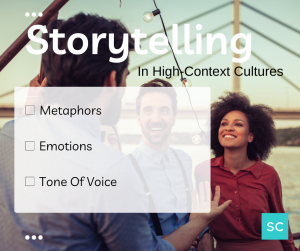Working In High-Context Cultures
You will know you are walking into a high-context culture situation when you can sense the people around you aren’t being as explicit in what they are trying to say. Those in high-context cultures value more implicit types of communication.
How you carry yourself, and your body language, are the types of communications people in high-context cultures value. According to Glassdoor.com, high-context cultures will make many decisions in person rather than behind closed doors.
In high-context cultures, things aren’t explicitly laid out. Parts of the Middle East, Asia, and Africa are generally high-context cultures.
1. Body Language
In a high-context culture situation, you will want to pay close attention to other people’s body language. This is because people in high-context cultures look for subtleties in body language as communication.
Consider the following:
- Eye Contact – In high-context cultures, eye contact is essential to communication. For example, when you are listening to someone speak, if you don’t make eye contact, it appears like you aren’t interested in what they have to say. On the other hand, if you are speaking and you don’t make eye contact, it could come across as if you are not genuine or can’t be trusted. Make sure your eye contact matches your message, especially in a high-context culture.

- Posture – Your posture, or the way you carry yourself, is critical in a high-context culture. For example, if you regularly hunch your shoulders, you may come across as not confident or disinterested. You want to carry yourself in a way that communicates your thoughts. This is because high-context cultures take cues from body language as communication.
- Gestures – Your gestures can communicate much to the people listening to you speak. For example, if you are talking about an upcoming merger and constantly clenching your fists and waving them around, it would appear you aren’t happy about the merger. People in high-context cultures will pay more attention to your gestures to determine what message you are trying to convey.
In high-context cultures, your body language is an informative piece of communication. Make sure you are aware of the message your body language sends.
2. Storytelling
Storytelling is a valued form of communication in high-context cultures. Often, these cultures will use emotion to convey their message. Understanding different forms of storytelling can help you work more productively in high-context cultures.
Consider the following:
- Metaphors – A metaphor is a figure of speech. These figures of speech take an object and apply an idea to it. For example, you could say, “That meeting was a zoo.” Or, “His words cut me to my core.” The meeting wasn’t actually a zoo, but with the metaphor, you are trying to convey how disorganized or chaotic the meeting was. And words don’t actually cut people, but the metaphor describes how hurt you were by the words spoken.
- Emotion – Often, the goal of storytelling is to evoke an emotion. In high-context cultures, people may use emotion through storytelling to express how they feel, rather than explicitly state it. For example, instead of saying, “I want you to get really excited about what I am about to say.” Someone might tell a story about a triumph to get people in the right headspace for their big announcement.
- Tone of Voice – In high-context cultures, your tone of voice is fundamental. When you use storytelling to convey a message, how you tell the story with your tone of voice can determine how your audience receives your message. For example, if the person speaking to you is very monotone, you can probably assume they aren’t very interested in the story they are telling. However, if they vary their tone of voice and use it to create suspense, they are probably very excited about their message.
 High-context cultures will use storytelling to convey their messages. Pay close attention to the metaphors, and emotions being expressed.
High-context cultures will use storytelling to convey their messages. Pay close attention to the metaphors, and emotions being expressed.
3. Decision-Making
In high-context cultures, decisions aren’t generally made as straightforwardly as in low-context cultures. Instead, how people feel about things is just as important as the facts.
Consider the following:
- Go With Their Gut – In high-context cultures, decisions are often made with their gut instinct. In other words, the person feels a certain way and decides to decide based on a feeling. For example, even though Jane doesn’t have as much experience as Nancy, you feel like Jane is the right fit for the job.
- In-Person – Decisions in high-context cultures are usually made in person. This is because high-context cultures heavily value body language, and subtleties to make decisions. For example, instead of your boss emailing you to tell you about an upcoming project, your boss would ask you to come into their office to discuss it. This way, your boss can read your body language and see if you have any reservations about the upcoming project.
Don’t be surprised if you are asked to speak about things in person rather than through emails in a high-context culture. Awareness will help you prepare your message and be more confident when speaking.
When people use more implicit forms of communication to get their message across, you will know you are in a high-context culture.
___
Whenever you’re ready, there are 3 ways we can help you:
- Discover your communications style so you know where to start. Over 4,000 people have found theirs here.
- Attend our monthly communication workshop to build communications confidence (new topics: public speaking, advocating for yourself, building credibility, etc) here.
- Get your brand in front of 43k+ people by sponsoring our newsletter or Soulcast Media | LIVE LinkedIn events [contact: hello@soulcastmedia.com]











